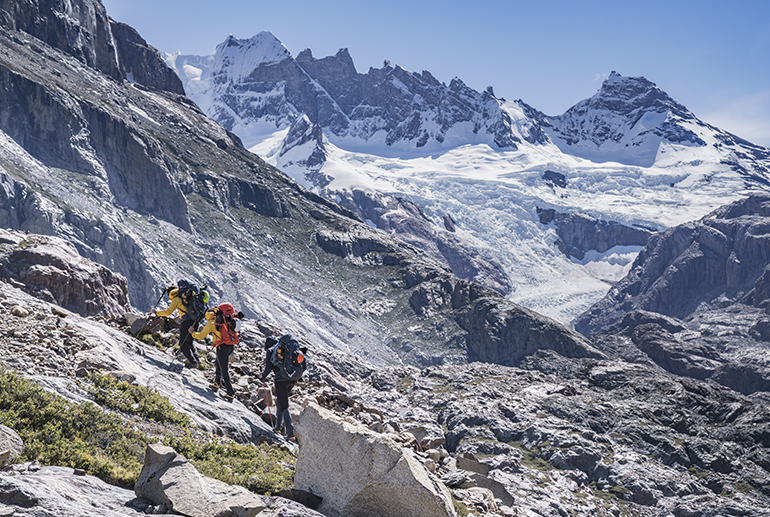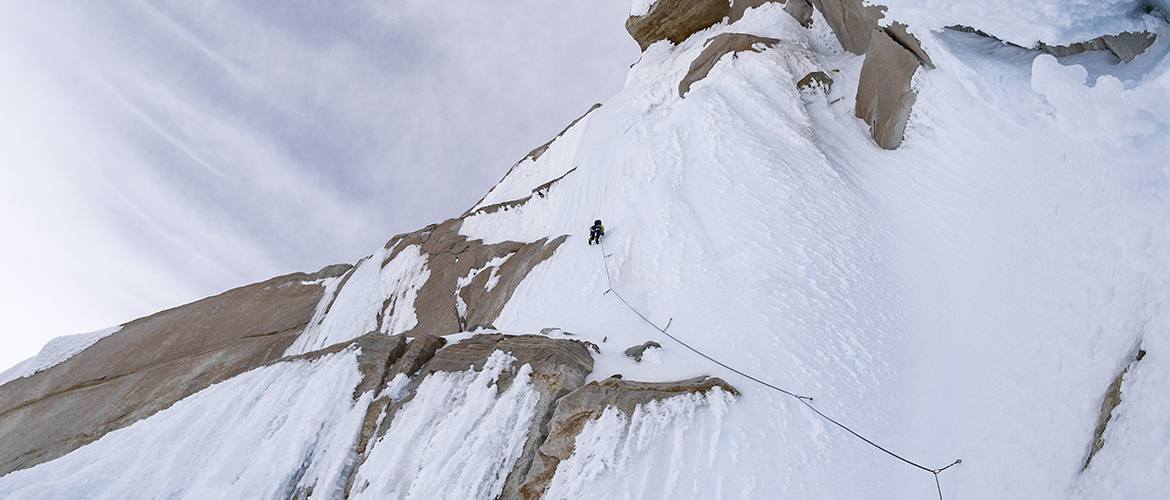THERE IS NOTHING TO SEE IN PATAGONIA
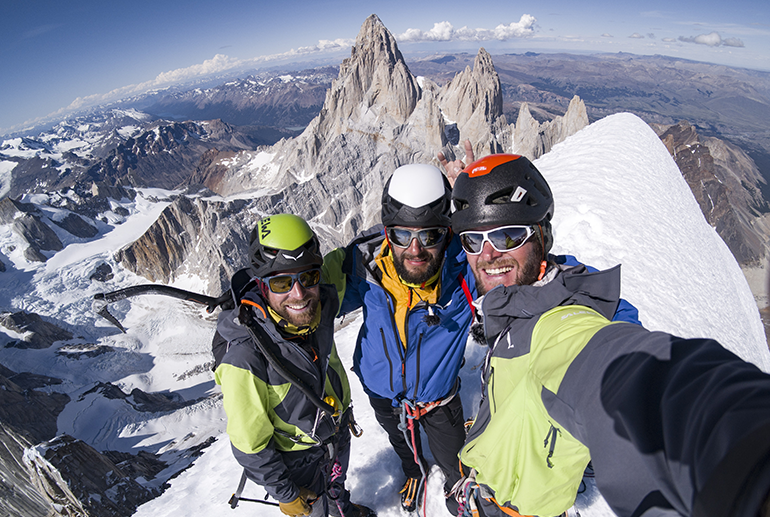

“There is nothing to see”. As if to say: it’s not worth it, forget about it. “I didn’t see anything” – as if to say: I’ve wasted my time. As if “seeing” is not worth it. As if “not seeing anything” is a waste of time. How much does seeing condition our experiences in the world?
For example, Gabriel cannot see. Well that is not exactly right: to tell you the truth, Gabriel Tschurtschenthaler, who is 35 years old, is 90% blind. Yet, what Gabriel enjoys the most is spending his time in places which people go to “see” or for the “breathtaking landscape” or “from up high you can see further”.
You need to make a plan
Gabriel and Vitto have known each other for approximately five years. Vittorio Messini known as Vitto is a mountain guide and Gabriel met him as a client. No big deal, just a person who wanted to learn to ice climb – well apart from the fact that this person cannot see. Apart from the fact that not seeing anything he is still three times as strong, determined and as motivated. And it is from these foundations that their relationship has evolved, from a normal relationship between a guide and a client, into a solid friendship.
Below Großglockner two alpinists stop off and have a bite to eat after three days at high altitude. “Gabriel, would you like to come to Patagonia?“ Vitto asks, calmly sipping a beer. “You are so fit, and you are as nimble as a cat on ice. I really think you would be able to climb the Ferrari or the Ragni route, on Cerro Torre”.
Gabriel scratches his beard for a long time. The idea is enticing, but Patagonia isn’t exactly round the corner. It’s not the climbing that worries him. He is at ease on the wall, it is the approach walk that worries him. Rocks, roots, uneven terrain for kilometers, carrying gear on his back – climbing gear, base camp gear. It is no walk in the park. “When do we leave?” He answers without hesitation.
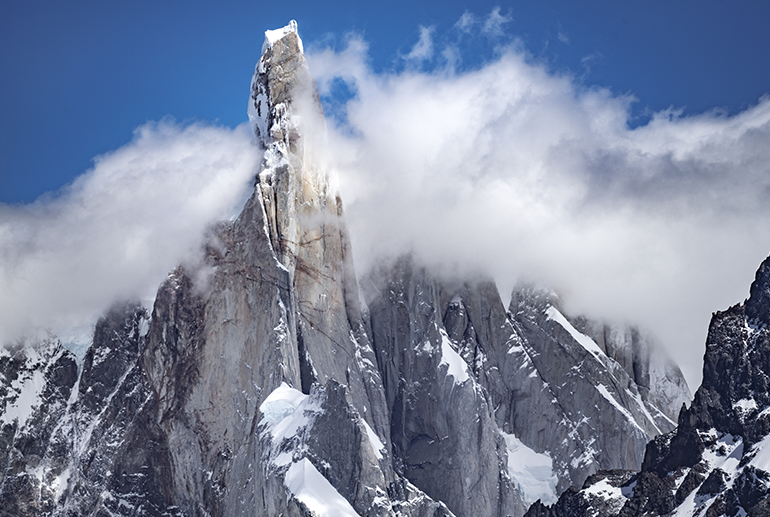
Getting ready
You need to be prepared before tackling such a journey. Logistically, but even mountaineering wise. For example when choosing a third team member: Matthias “Motz” Wurzer, a friend of Vittorio’s is gladly part of the team. Or for example some outings are required, to prepare physically, to get manoeuvres down to a tee and develop group dynamics: such as Prijakt Nordrinne, Südwandwächter on Glockner, or some ice falls, such as Kesselfall and Mordor. Nice routes such as Comici-Dimai on the north face of Grande di Lavaredo. Adequate preparation is needed as is a lot of patience. The same patience needed when going to Patagonia, waiting for a good weather window, or the patience needed during the pandemic, waiting for the infections to decrease, for the restrictions to ease, waiting to travel again. Even that is training in a way.
The right time?
It seems that towards the end of 2021 the cogs of the world’s machinery start working again, at least for a while. During November Gabriel, Vitto and Motz manage to reach El Chalten. Practicing patience as expected turns out to be necessary. It rains, the wind blows, there is a storm. A first, short window seems to allow for an excellent plan B: an attempt on Po, that is, Aguja Poincenot, Fitz Roy’s neighbour.
The approach is long and uneven. “Right, left, one step, watch out, there is a large step, left, right, small bridge ...”. Vitto, ahead of the threesome, informs Gabriel on the terrain’s conditions. Gabriel processes the information quickly and adapts his steps. If the itinerary becomes more difficult, a stick is used as a connection to the ground, and when the path is steeper, the person preceding Gabriel acts as a connection with their backpack.
It has rained, now the sun is shining: the snow is soft and while making tracks the snow is waist high. Twelve exhausting hours of walking before setting up camp to enjoy a night at -14°C.
During night time the wind howls and there is nothing to see. What stories does the wind tell us? What voice does it carry with us, from afar in space and time? It howls during the day, the wind, and even during day time it brings with it stories and far away voices. But it is during night time, when there is nothing to see, that you can carefully listen to it.
The morning is clear. There is a lot of snow, the layers are not cohesive, the slopes are steep and the sun is warm: an excellent recipe for anyone looking for trouble, avalanche kind of trouble. The forecast for the afternoon: wind force is due to increase until it becomes a storm. There is nothing else to do except to turn back and return to El Chalten.
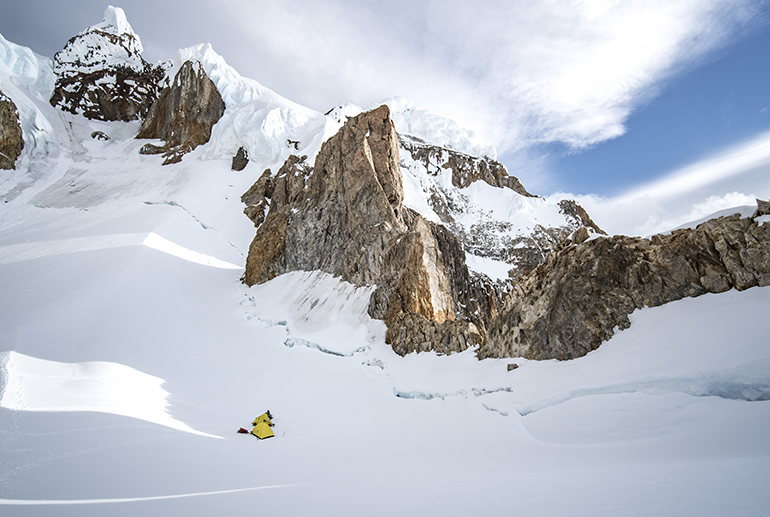
Po
It will take about a week before the weather improves and the snow becomes stable. The return to Paso Superior is easier, without carrying the weight of all the gear left on site, and there is more time to enjoy the ascent. The sound of snow underneath one’s boots, the slow breathing mixed with the breathing of one’s climbing partners, articulated by the shorter rhythm of three people’s heart beating. The feeling of sweat, fatigue, wind and sunrise on one’s skin. These are all things that are impossible to see.
Instructions change when moving vertically. They become more varied, more three dimensional. It concerns feet, hands, ice axe, body position. The route is a tale, a theory of movements described and carried out meticulously. A sequence which is concluded leaving room to silence and to the wind blowing on top of Po, Aguja Poincenot, and if you are really good, determined and stubborn it is possible to climb it even without seeing.
And what about plan A?
Plan B was awesome. But plan A is still an idea, an inviting, provocative, current idea - Torre, “scream of stone”, three thousand metres or more of granite crowned by ice. Time seems to stand in the way of it being climbed: the weather does too, as well as the passing of time. The bad weather persists and the date of the return flight is relentlessly approaching. The first possible window of good weather? Begins exactly on the date of the flight. “Well, let’s just move the flight then?” Gabriel suggests.
Above Circo de Los Altares the snow is soft: tiring to cross, but not dangerous. Three pitches of fourth grade to be climbed with all the camp’s weight on their backs lead Gabriel, Vitto and Motz to just under the west face of Cerro Torre. A year and a half of covid have kept anyone away from this place, you can sense that harsh solitude in the air. That is something else you cannot see. A night of labored rest, agitated and charged with expectations. A predawn awakening because every minute counts. Once again a long theory of gestures, told and executed with precision along the imagined line and then opened by the Ragni di Lecco in 1974.
Above the headwall there are vertical tunnels, pockets in the ice which are one and a half metres wide. You have to climb, crawl, dig. There is a bizarre echo, a predawn reflection which is impossible not to notice in this sort of gelid blue uterus. It takes two hours to scrape through the ice’s intimate belly, before popping out into the light. Onto the summit.
There is nothing to see
There is nothing to see. But is seeing so fundamental that it makes any non visual experience less interesting? We can climb in so many different ways. Why does this obsession exist for one of our senses? And what price do we pay to connect our experiences to images? How much do we ignore, omit, forget simply because it reaches our brains and hearts taking different paths than our optic nerves?
The answer is right in front of us. Crystal clear, however hidden in plain sight. Gabriel winked, while he started abseiling.
